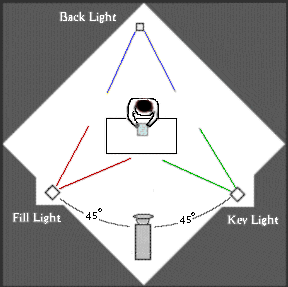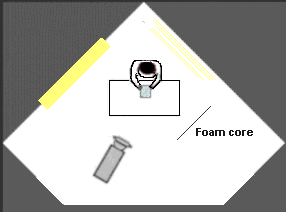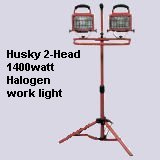| Gorilla Lighting
Ha! Got your attention, didn't I?
Of course it's guerilla lighting -- the expression used to describe lighting for your videos using inexpensive lights you can buy at
The Home Depot,Lowes or any well equipped hardware store, and modify for your video needs.
First, a quick note about lighting in general. Good lighting -- that is, lighting over which you have control -- consists of three elements, Key, Fill and Back light.
 Key Light and Fill Light -- We're accustomed to seeing things in nature illuminated by the sun, or by artificial light from fairly strong directional sources. Strong directional light creates a highlighted side and a less bright side, the shadow. Key Light and Fill Light -- We're accustomed to seeing things in nature illuminated by the sun, or by artificial light from fairly strong directional sources. Strong directional light creates a highlighted side and a less bright side, the shadow.
When lighting artificially, we use the Key Light to replace the sun. If we used the Key alone, the opposite side of the face would be almost black, as there would be little reflected light to help illuminate that side of the face. So we use the Fill light to soften the deep shadows created by the Key Light. The Fill reduces contrasts in the darker areas of your composition, helping the video camera to produce a better image.
The Key is commonly located about 45 ° to the right or left of the camera. The Fill is commonly located 30
to 45 ° from the camera, opposite the Key, and at the same height.
Back Light -- Back light is used to create visual separation of the subject from the background. It creates a halo of light on the hair and shoulders of your subject, or on the top of objects you are video taping. Like the Key and Fill, it should be about 45 ° above the subject (if possible), and should be on as close to a direct line with the camera as is practical.
 |
The less you have to tinker with lighting the better. So, for a start, make use of the sun, even indoors . Have your subject sit near a window, with the light illuminating the side of her face. That will be your key light. On the side away from the window, hold up a large sheet of white cardboard -- an art supply product called foam core is ideal -- to bounce light from the window onto the opposite side of your subject's face -- the fill. Your back light will come from the sun bouncing off the white wall behind your subject's head. |
If there isn't enough natural light, you could buy studio lights, or go to Hollywood Lights, Inc. and rent professional equipment. But you can achieve some really good lighting using low-cost lights from the hardware store.
|
Halogen work lights, the kind that come two-to-a-stand or, for special use, a model that sits on the floor are excellent for lighting large spaces, indoors or out. These are very bright and very hot, and provide an excellent white light. For best results, bounce the light off a wall, ceiling or other reflective surface (e.g., foam core) rather than shining it directly onto your subjects. Never, under any circumstances, should anything be put close to these lights as the danger of fire is considerable!
You can often also find inexpensive scoops, big aluminum bowls with a handle and clamp, at hardware and photo shops. It's almost impossible to control light being reflected by a scoop, but they're fine for when you simply need to increase the overall light level in a room. Here again, bounce the light off a reflective surface. For big reflectors, try using a silvered tarp from the hardware store. They come in assorted sizes.
|

|
An alternative to a reflector is a diffusing medium, a bed sheet, for example. Don't put it anywhere near a halogen light or an aluminum scoop -- you'll set it on fire. Instead, try stretching it across a doorway and put the light in the next room, several feet from the sheet. Or have a couple of helpers hold the sheet several feet in front of your light. You can also use a sheet (or sheets) across a window to minimize the glare and soften the light. Be sure to white balance your camera before you begin shooting, so the camera "knows" what white is supposed to be.
For a much more subtle light source, ideal for illuminating faces and table-top projects, look for fluorescent trouble lights (work lights), the kind you might use under the hood of your car. You'll find the two-tube variety -- they're about a foot long, with a hook on the top -- in two intensities: 2800K and 6500K. These equate roughly to incandescent and sun light. Set up the white balance on your camera accordingly and your subject should look great. The advantage of lights like these is that they draw very little electricity and are extremely cool. You can mount them just a foot or two from your subject, just out of camera range.
Finally, if you're feeling really adventuresome and plan on doing lots of video work with interviews, conversations with family members for a history, etc., consider using a China ball for soft illumination, used for this purpose since the early days of film making.
Have fun with your movie making and remember: shedding a little light on your subject makes a world of difference to those who are watching your videos.
You can find lots of additional tips to enhance your videos in the tips section of our web site, in Lighting Tips and in our collection of "Timely Tips".
After you look at our tips, send us your tip.! If you have questions, let us know them, too. We're here to help you produce better video!
Top of Page
|

